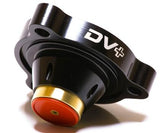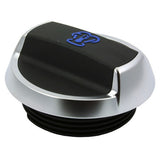GFB Diverter Valve DV+ 14+ Audi S3 / VW Golf R 2.0T (Direct Replacement)
Introducing the new DV+ for The VW MK7 Golf R and Audi 8V S3
GFB’s DV+ solution couldn’t be simpler - keep what works and replace what doesn’t.
Patent and Design Patent Pending
- Designed specifically for Mk7 Golf R and 8V S3
- Delivers DV+ performance benefits
- No need to cut, bend, or grind your baby, just the usual precision engineered GFB solution
- OE appearance
- Retains the factory solenoid coil for seamless integration
- Replaces plastic valve parts with metal for reliability and strength on chipped engines
- Direct-fit replacement with GFB’s TMS benefits
- Exclusive “pilot-actuated” valve mechanism for rapid response at high boost
GFB expands the DV+ range with a direct-fit direct-fit diverter solution specifically designed for the VW Mk7 Golf R and Audi 8V S3 (2103-on).
The Mk7 Golf R and Audi 8V S3 use a bigger turbo than the GTI and A3, which is great for performance, but bad for fitting diverter valves! The space taken up by the larger turbo means the usual GFB T9351 DV+ cannot be used on these models, unless you’re ok with grinding and bending stuff to make it fit.
Since we’re not ok with that, we engineered a better solution! The T9359 DV+ features a bespoke billet aluminium body that, whilst larger than the T9351, re-orients the solenoid to gain the clearance required for a perfect fit with an “OE look”, and of course the DV+ performance benefits.
Drive with confidence knowing that we’ve taken care of the engineering.
Why fit a DV+?
The solenoid coil itself from the factory-fitted valve is great (the ECU opens it faster than any pneumatic valve so why replace it?), but the problem is the plastic piston valve mechanism. So GFB’s DV+ solves this problem by replacing just the valve parts with an anodised billet aluminium housing fitted with a brass piston machined to exacting tolerances.
The end result is sharper throttle response, lightning-fast valve actuation, and it will hold as much boost as you can throw at it. Read all about the DV+ story below.
Other manufacturers’ products involve replacing the entire system with a traditional pneumatic valve, requiring long vacuum hose runs, additional parts for tapping into the intake manifold vacuum, plus either a different solenoid valve to actuate the pneumatic valve or a ballast resistor to plug into the OE wiring loom. All these additional items result in a product that is slower, less responsive, more expensive and takes much longer to install.GFB’s DV+ solution on the other hand is more responsive, less expensive, easier to install, and doesn’t cause compressor surge/turbo flutter. Oh, and it doesn’t require different springs or frequent re-builds.
GFB’s DV+ solution on the other hand is more responsive, less expensive, easier to install, and doesn’t cause compressor surge/turbo flutter. Oh, and it doesn’t require different springs or frequent re-builds.
All late-model European cars these days are using ECU controlled solenoid-type diverter valves. This is a good concept because the valve can react very quickly and it only opens when it needs to.
However, there are some problems with these valves. Since they first appeared on VAG vehicles in 2006, there has been at least 5 different revisions owing to reliability issues. Without going into detail of the revision history, the latest revision C found on the Mk7 R and 8V S3 can still be improved upon. Whilst it is stronger and leaks less than previous revisions, it is still limited by its operating principle – being a direct solenoid operated valve, it can only operate in two states, open or shut. Unfortunately, cars don’t typically operate in two states – your accelerator isn’t a switch, and progressive relief of boost pressure during partial throttle closure is not possible with the factory diverter.
T9359



![[Super Deal] XADO maximum](http://www.sliptuning.com/cdn/shop/products/xado_3_compact.png?v=1397187246)








